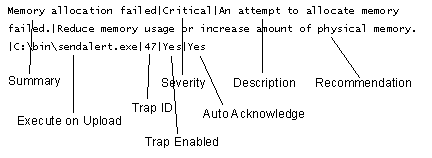


|

|
|
|
|
Log Central Message and Message Definition Formats
A Log Central message consists of a message header and a message body. A message definition is associated with a message based on the message ID and subsystem values in the message header. The following sections provide detailed descriptions of the Log Central message and message definition formats:
Example of a Log Central Message and Message Definition
For information about how Log Central constructs a log message, see Construction of Log Messages in Overview.
Example of a Log Central Message and Message Definition
The following figure shows the fields that are in a Log Central message.
Figure A-1 Log Central Message Fields
The following figure shows the fields that are in a Log Central message definition. Figure A-2 Log Central Message Definition Fields
The following sections describe the fields in a message header: For more information about message headers, see IL_SM_LOG_TABLE: Message Header Definition in Database Schema.


|
Description: |
Logging level |
|
Format: |
Character |
|
Size: |
1 character |
|
Range: |
Possible values:
|
|
Optional?: |
Not optional |
|
Corresponding Field: |
In the IL_SM_LOG_TABLE database table: MSG_REP_MODE |
|
Description: |
PID of the process that generated the message. |
|
Format: |
Integer |
|
Range: |
1 through 99999 |
|
Optional?: |
Not optional |
|
Corresponding Field: |
In the IL_SM_LOG_TABLE database table: MSG_PID |
|
Description: |
User ID of the process that generated the message. |
|
Format: |
String |
|
Size: |
Up to 8 characters |
|
Optional?: |
Not optional |
|
Corresponding Field: |
In the IL_SM_LOG_TABLE database table: MSG_UID |
|
Description: |
Text determined by the application developer. |
|
Format: |
String |
|
Size: |
Up to 2000 characters |
|
Optional?: |
Not optional |
|
Corresponding Field: |
In the IL_SM_LOG_TABLE database table: MSG_TEXT |
The following sections describe the fields in a message definition:
For more information about message definitions, see:

|

|

|
|
|
|
Copyright © 2000 BEA Systems, Inc. All rights reserved.
|